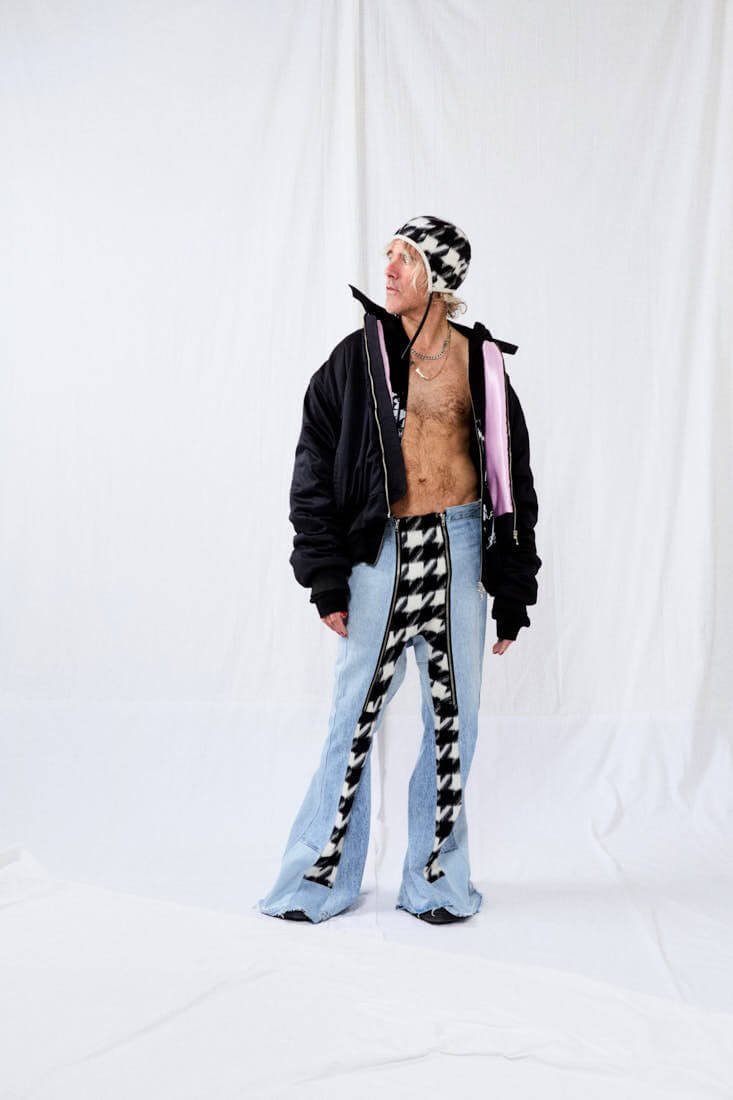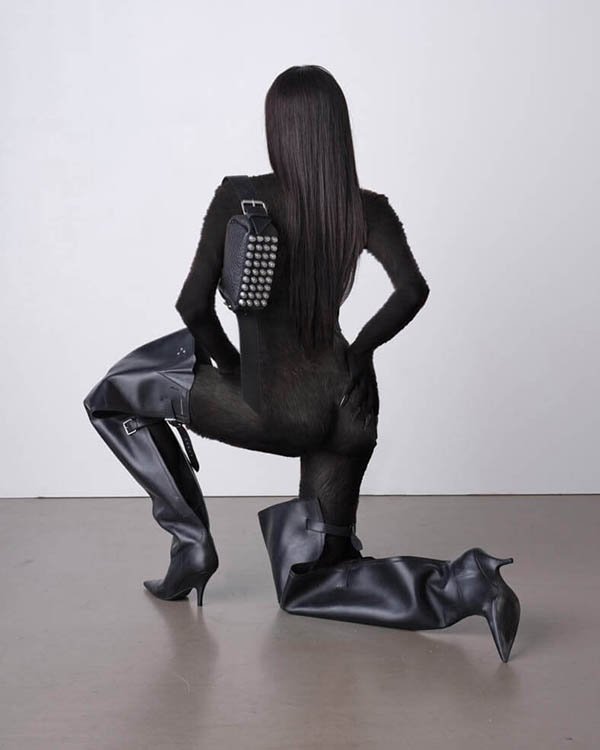SPENCER CARROLL
*Chromatic Visions
written + interview TAGEN DONOVAN
Spencer Carroll is emerging as a distinctive voice in the fashion industry, capturing attention with a compelling blend of heritage and innovation.
A recent graduate of Central Saint Martins, Carroll’s work stands out for its seamless integration of traditional influences with modern, forward-thinking designs. Each garment not only showcases the designer’s technical skill but also reflects a unique ability to engage viewers through visual deception and a playful sense of nostalgia.
Alongside Carroll’s formative material experimentations, his early involvement with the sport of fencing played a crucial role in shaping his design ethos. The sport’s protective uniform introduced him to the concepts of structure and protection—elements that have become central themes in his design philosophy. This influence prompted a departure from conventional fashion boundaries, evolving each collection into complex constructions that challenge traditional perceptions of clothing. Carroll artfully balances vulnerability with strength, reflecting the protective and transformative aspects of fencing, which continue to permeate his practice, imbuing each piece with layers of meaning and complexity.
Spencer Carroll, atelier
“I tend to draw inspiration from my immediate surroundings. As for my philosophy, I believe it cannot be pinned down; it is an ever-evolving space.”
Spencer Carroll speak with Tagen Donovan
for LE MILE Issue N3. 37 - AGE OF CHANGE
Tagen Donovan
How would you describe your design philosophy?
Spencer Carroll
I tend to draw inspiration from my immediate surroundings. While maintaining a very optimistic outlook, which also informs my perspective. Altogether, these elements work together in guiding my exploration into contemporary and dynamic areas. And as a naturally curious person, I’m constantly observing and engaging with everything around me. As for my philosophy, I believe it cannot be pinned down; it is an ever-evolving space.
Can you walk through the process of developing your graduation collection from initial concept to final execution?
The concept was developed in response to specific art galleries and exhibitions. Viewing the works of Jeff Koons and John Chamberlain, and observing the craftsmanship required to create these metal structures, was truly inspirational. Further exhibitions showcased by Mika Rottenberg (’GRUPPENAUSSTELLUNG’ at Hauser & Wirth) and Senga Nengudi (DIA Foundation, Beacon) reinforced my connection to the colours, textures, and shapes that were evolving in my mind. It provided the visual confirmation that I needed to pursue the collection, merging art with fashion.
Once I had finalised my concept, I began designing the shapes. The initial stage of experimentation involved a long, playful period of absorbing all of the elements. In part, this approach led to a refinement process, ensuring that the collection was both wearable and desirable. Throughout the conceptualisation stage, it was key to keep the influence of art integrated, defining the shapes within the narrative.
Your collection aims to evoke a sense of playful nostalgia. How do you see this balance between past and present fitting into a broader narrative of cultural change and modern expression?
By drawing on nostalgia, it compels one to reflect and process ideas with a contemporary expression. Sometimes, you might not realise that you are referencing the past because you are working on it in the present; thus, all the modern elements naturally integrate into your narrative subconsciously.
Although the objects I create are physical, they often acquire a much larger presence in the digital realm. Similar to art, clothing is viewed through various media formats, and stories are shared on social media. Therefore, a digital presence is crucial to me as a designer. My collection translates well into the digital space, which is a modern expression that will continue to resonate.
What aspects of Koons' and Chamberlain's work resonated with you the most, and how did you reinterpret these elements to reflect the cultural metamorphosis we see in today's fashion landscape?
With both of these artists there is an alchemy at play. Chamberlain's sculptures, made from steel auto parts, turn something that was designed to be of use – that had a previous life – into powerful pieces of art. It is this transformation of auto parts into these beautifully and intricately constructed sculptures that is so compelling. The shape of his works influenced the silhouettes within my collection.
Koons’ work draws on pop iconography and advertising to create unique and highly desirable pieces of art. Seeing his colourful balloon sculptures in a bright white gallery, with all of the reflections of the gallery environment, was incredibly inspiring. They naturally felt fashionable to me, so it was an easy transition to incorporate their appeal into my collection. There is an optimism in Koon‘s work which I’ve always loved.
Drawing further inspiration from shiny objects, packaging, and digital brights found in newsagents and market stalls, how did you ensure that these everyday inspirations maintained a cohesive and elevated aesthetic in your collection?
These elements are very much a part of my childhood memory and provide an atmosphere that I wanted to incorporate into my collection. At first, I fully indulged in exploring these elements to an extreme via the methods of drawing and production of prototypes. As I began the process of gradually refining to a core essence, this latterly informed my final designs.
My initial experiments were not about clothing per se , but a more literal take on art and playfulness, using balloon shapes and forms wrapped around the body. I didn’t want that element to be filtered out. In essence, each outcome of the engineered prints were maintained with the refinement of the silhouettes.
The rigorous process of playfulness and experimentation gradually distilled into the final pieces, through colour and maintaining the integrity of the story.
In the spirit of radical creativity, how did you incorporate the idea of visual deception, seen in Koons' solid aluminium works, in your garments?
It was important to me to honour the visual deception evoked in Koons' work—the play of the illusion of metallic foil fabric giving the appearance of inflated parts – when the reality is that the fabric is not metallic and that the parts are not inflated. I liked the blend of the overall play on the theme of Koons' work into a fashion landscape.
Can you explain the techniques you used to create the illusion of inflated structures and metallic sheens, and how these methods represent a blend of innovation and traditional craftsmanship?
After I finalised the concept, I produced a high volume of photography to capture the light diffusion on the balloon's surface. Metallic balloons have a joyful appeal to me, and I knew the print needed to be strong. It took a lot of print and colour testing, alongside fabric selections to get the right finish. The digitally engineered prints involved copious experimentations and perfecting, in order to maintain the desired visual impact.
What were some of the biggest challenges you faced while creating this collection?
Maintaining the integrity and desire to fabricate them as if they are pieces of art was a constant focus for me in this collection. Also, blending this process with intricate garment detailing through precise pattern cutting was essential to the collection's success from its conception.
Each silhouette was carefully designed and draped. Ultimately, the real challenge was rooted within the engineering of the prints—ensuring believability through rigorous material trials, while integrating sculptural elements.
From your experience at CSM and your professional roles at AREA and Alexander Wang, what do you see as the biggest challenges for new designers entering the industry today?
CSM is an incredible environment to experiment – allowing space for challenging yourself and your perceived limitations. Similarly, my roles at AREA and Alexander Wang made sense of the reality of the industry. Fashion thrives on experimentation, and both brands encourage forward thinking and creative ideas. Overall, the challenges for new designers and production within the industry will be to embrace environmentally sound practices. I believe this may become apparent through the means of technology and innovation. Looking towards the future, I am confident that we will see change, as at the core of design is an intrinsic link to change.
Now that you’ve graduated, what’s next for you and your label?
My immediate plan is to work within the industry, perfect my craft, and learn the business. I am currently creating the 'Chromatic Inflation' made-to-order capsule collection. This made-to-order approach aligns perfectly with the brand’s ethos of creating truly dynamic garments and artworks. Looking more broadly to the future, I am also working towards exhibitions in London and New York. These exhibitions will continue my exploration of the materiality of fashion fabrication and contemporary art, allowing me to showcase my work to a broader audience. While continuing to develop new collections, each inspired by themes discovered by art and my immediate surroundings.
Spencer Carroll, portraits
“By drawing on nostalgia, it compels one to reflect with a contemporary expression. A digital presence is crucial to me as a designer.”
Spencer Carroll speak with Tagen Donovan
for LE MILE Issue N3. 37 - AGE OF CHANGE
Visually inspired by the iconic inflated art of Jeff Koons and the welded metal sculptures of John Chamberlain, Carroll adeptly translates the gleaming, reflective qualities of these robust art forms into fashion. The paradoxes in these works—such as the illusion of inflated balloons in Koons’ solid aluminium sculptures—provide the conceptual foundation for Carroll’s latest collection. Each garment amplifies these contradictions, appearing both light and airy yet grounded in meticulous craftsmanship. This is achieved through Carroll’s innovative use of photographically engineered prints, which create the illusion of inflated structures within his garments. By combining high-resolution digital imagery with textile manipulation, he replicates the appearance of volumetric forms and metallic surfaces with remarkable precision.
Spencer Carroll stands out as a designer who deftly navigates the intersection of tradition and modernity, engaging profoundly with the ongoing dialogue between the past and the future. In an era marked by rapid transformation, Carroll’s approach to fashion is both a tribute to historical craftsmanship and a bold leap into contemporary innovation. His work, distinguished by a seamless blend of time-honoured techniques and forward-thinking principles, reflects the zeitgeist of an age characterised by significant cultural and technological shifts. Through his creations, Carroll not only mirrors current trends but also embeds his designs deeply in the narratives of change, defining a new chapter in the evolving story of fashion.
visuals (c) Spencer Carroll, 2024





























































































































